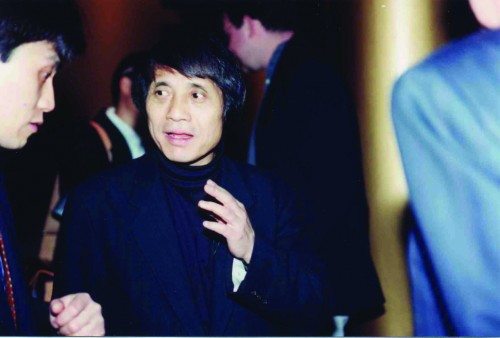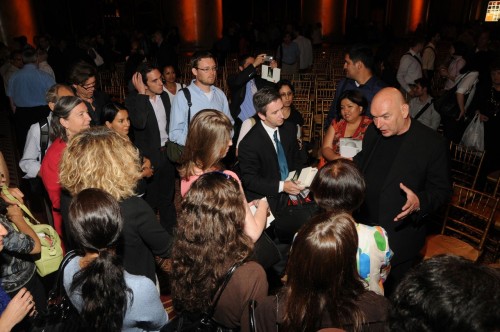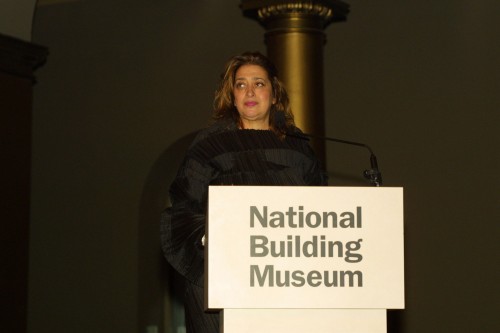Tadao Ando, March 2, 2002. Image Courtesy of the National Building Museum.
Since 1997, the National Building Museum has been offering professionals, tourists, and aficionados the opportunity to hear some of the most distinguished architects and designers in the world speak about their passion. Paul Kilmer, Director of Public Programs, introduces the Spotlight on Design speaker series as an occasion to “celebrate an architect, designer or firm, and give them the opportunity to share with us the significance of their work – celebrating design innovation”. Furthermore, it allows us to “demonstrate how critical and important good design is to quality of life”, says Kilmer. Past speakers have included Pritzker Prize Laureates, American Institute of Architects’ Gold Medalists, and the American Society of Landscape Architects’ Medal recipients.
Oh how I would have given anything to be a fly on the wall when Tadao Ando presented!
In the spirit of the Spotlight on Design speakers series, We Love DC chats with Martin Moeller, the Senior Vice President and Curator of the National Building Museum, who gave us some details about the makings of the wildly popular lecture program and how he feels about design and architecture in D.C.
Please Note: The answers to all but the first two questions are PERSONAL OPINIONS, and should be explicitly presented as such. They do not represent any official positions of the National Building Museum.
We Love DC: What is the Spotlight on Design program?
Martin Moeller: Spotlight on Design is a long-running, very popular lecture series at the National Building Museum. It brings talented architects, landscape architects, and other designers to the Museum to speak about their work. Past speakers include many of the most famous practitioners in the world, along with others whose reputations are only starting to develop.
WLDC: What inspired you to develop the series?
MM: We realized that there are lots of people in Washington who are eager to learn more about contemporary architects and designers. Spotlight on Design provides an ongoing forum in which people can hear directly from creative individuals about their work.
WLDC: Who would be your dream speaker for the series?
MM: We have already had many extraordinary speakers, and given that track record, I am confident that we will eventually get most of the other ones I am eager to hear.
So I would have to think in terms of the impossible—people who are no longer alive. How about one of the great 18th-century French visionary architects, like Étienne-Louis Boullée? Or maybe Raymond Loewy, the industrial designer who created household objects, cars, and trains that seemed like works of architecture?
WLDC: What is the single best piece of advice given by a speaker?
MM: I can’t think of one single statement, but a number of speakers have said, in various ways, that their goal is to create buildings and landscapes that make the world a better place.
Jean Nouvel, June 3, 2008. Image Courtesy of the National Building Museum.
WLDC: How do you see the Sustainable Movement impacting the way we space?
MM: I hope it will have an enormous impact, and I think it has already been significant. I think that the growing awareness of sustainability is already beginning to strengthen our cities as people once again appreciate the value of denser development, and may be encouraging people to value quality over quantity in design and construction.
WLDC: Where do you think D.C. fits into the architecture and design movement?
MM: Washington has a reputation as a conservative city in terms of architecture and design, and while there is obvious truth to that, I think it is overstated. At several points in its history—in the 1960s, for instance—Washington was the site of numerous buildings, proposed buildings, and urban plans that were in keeping with the more progressive trends in the profession. Washington is home to a number of very talented practitioners doing world-class work. I think the city’s reputation as a center of design will gradually expand over the next couple of decades.
WLDC: What about D.C.’s architecture and design excites you?
MM: Washington has a number of spectacular neighborhoods, with great architectural character, walkable streets, and vibrant commercial centers. These places, rather than the Monumental Core, are the parts of the city that get me excited on a regular basis.
Nonetheless, having lived in Washington for 26 years, I still try to get a seat on the left side of the plane if I am going to be flying into National Airport. If I luck out and the plane approaches from the north, I get a thrill as the view of the city unfolds—first upper northwest, then the National Cathedral, then Georgetown, and finally the spectacular view of the entire Mall punctuated by the Washington Monument in all its noble simplicity. Now that’s urban design.
WLDC: Where are your favorite places in D.C. to go and find inspiration?
MM: I like places with lots of people—U Street on a Saturday night, M Street in Georgetown on a weekend day, Dupont Circle anytime it’s warm and sunny.
Zaha Hadid, November 6, 2002. Image Courtesy of the National Building Museum.
WLDC: In your opinion, what are the top five most ‘architecturally great’ buildings in the city?
MM: That’s an impossible question to answer, because even if I could come up with a firm list now, by tomorrow the list would be different. I will say that some of my favorites in no particular order include the Finnish Embassy, Union Station, the East Wing of the National Gallery of Art, the Hecht Company Warehouse, and of course, the National Building Museum.
WLDC: What, in your opinion, is the most underrated architecture or design spot in D.C.?
MM: The German Chancery, on Reservoir Road, is one building that comes to mind. It’s a beautifully sited building, with richly layered façades—a delicate composition of wood, metal, and glass. Another is the Dumbarton Oaks complex, with its elegant historic house, fascinating Pre-Columbian wing by Philip Johnson, and beautiful terraced landscape.
WLDC: Is there a D.C. neighborhood that stands out amongst the rest when it comes to architecture and design?
MM: As I said, there are lots of great neighborhoods in DC, but Dupont Circle may be the pinnacle in terms of the variety of interesting and beautiful houses and institutional buildings. But there are so many others!
The next Spotlight on Design will feature Warren T. Byrd, Jr., a world-renowned landscape architect, and will be held on September 20th. For more information please contact the National Building Museum at 202-272-2448.



Pingback: Tweets that mention A We Love DC Interview: Spotlight On Design » We Love DC -- Topsy.com